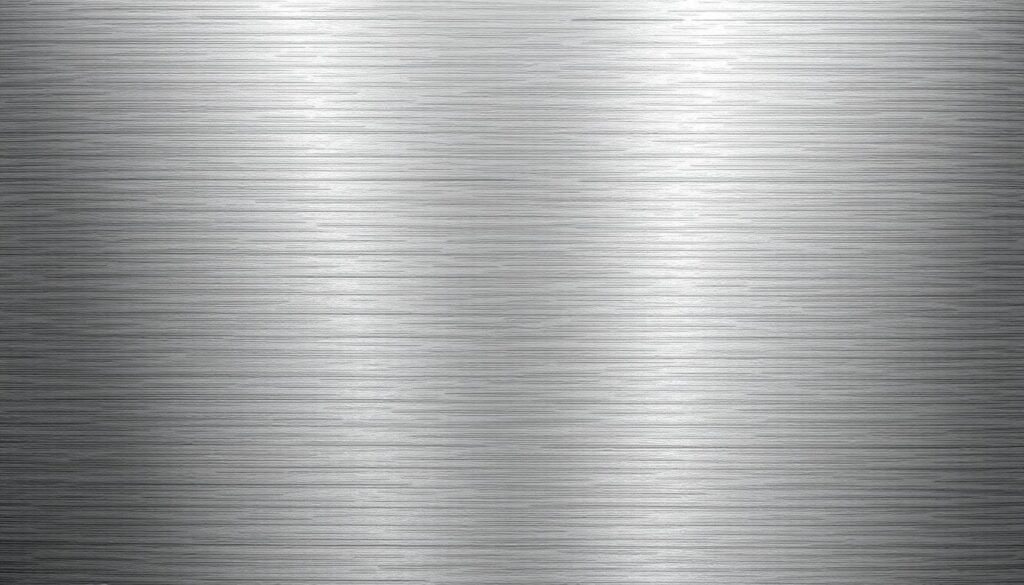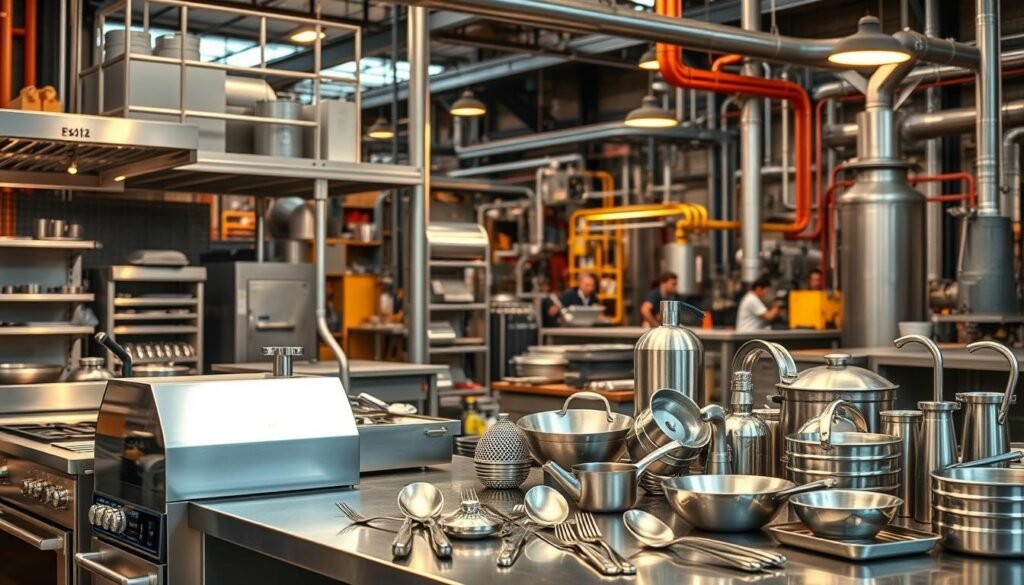Stainless steel is renowned for its durability and resistance to corrosion, making it a staple in various industries.
At its core, stainless steel is an alloy that contains a minimum of 10.5% chromium, which forms a thin oxide layer on its surface. This layer is crucial as it provides the metal with its trademark corrosion and rust resistance.
Type 201 Stainless Steel, an austenitic chromium-nickel-manganese alloy, was developed as a cost-effective alternative to conventional chromium-nickel steel grades like 301 and 304.
This comprehensive guide will explore the unique characteristics of 201 Stainless Steel, its composition, properties, and applications, as well as its corrosion resistance and limitations.
Understanding Stainless Steel Basics
Understanding the basics of stainless steel is crucial for selecting the right material for specific uses. Stainless steel is not a single entity but a family of corrosion-resistant alloys that contain a minimum of 10.5% chromium content.
What Makes Steel “Stainless”
The term “stainless steel” refers to its resistance to corrosion, which is primarily due to its chromium content. The chromium forms a thin, transparent layer of oxide on the surface, protecting the underlying material from corroding. This characteristic makes stainless steels highly durable and suitable for a wide range of environments.
Major Classifications of Stainless Steel
Stainless steels are categorized into several types based on their microstructure. The main classifications include austenitic, ferritic, martensitic, duplex, and precipitation-hardening steels. Each type has distinct properties and is suited for different applications. For instance, austenitic stainless steels, such as grade 201, are known for their formability and weldability, making them ideal for various types of projects.
The classification of stainless steels can be summarized in the following table:
| Type | Characteristics | Common Applications |
|---|---|---|
| Austenitic | Excellent corrosion resistance, formability, and weldability | Kitchenware, architectural features, and industrial equipment |
| Ferritic | Magnetic, good corrosion resistance, and less expensive than austenitic | Automotive exhaust systems and decorative trim |
| Martensitic | High strength, hardness, and moderate corrosion resistance | Cutlery, surgical instruments, and turbine blades |
What is 201 Stainless Steel
Understanding 201 stainless steel requires delving into its composition, characteristics, and development history. This type of stainless steel is part of the austenitic family, known for its versatility and cost-effectiveness.
Origin and Development
Type 201 stainless steel was developed as a more economical alternative to other austenitic stainless steels, such as Type 304. It achieves this through the substitution of manganese and nitrogen for some of the nickel, reducing the overall cost without significantly compromising on performance.
Chemical Composition
The chemical composition of 201 stainless steel includes a significant amount of chromium and manganese, with additions of nitrogen. This composition contributes to its strength, corrosion resistance, and other key properties.
Key Characteristics
Key characteristics of 201 stainless steel include its non-hardenability by thermal treatment, good formability, and weldability. It is non-magnetic in the annealed condition but becomes magnetic when cold worked.
| Property | Description | Benefit |
|---|---|---|
| Corrosion Resistance | Good in mild environments | Suitable for various applications |
| Magnetic Properties | Non-magnetic when annealed, magnetic when cold worked | Versatile for different uses |
| Formability and Weldability | Good formability and weldability | Ideal for complex shapes and joined components |

Physical and Mechanical Properties of 201 Stainless Steel
201 stainless steel exhibits a range of physical and mechanical properties that influence its performance. These properties are crucial in determining its suitability for various applications.
Strength and Hardness Specifications
The strength and hardness of 201 stainless steel are notable, making it suitable for applications where durability is essential. It offers a good balance between strength and formability, which is advantageous in fabrication processes.
Thermal and Electrical Properties
201 stainless steel has specific thermal and electrical properties that affect its behavior in different conditions. Its thermal conductivity and electrical resistivity are important factors in certain applications.
Corrosion Resistance Profile
Type 201 stainless steel is resistant to a variety of mild to moderately corrosive environments. While it offers good corrosion resistance in certain conditions, its performance can be compromised in environments containing chlorides or strong acids.
- It is suitable for indoor applications and environments with limited exposure to aggressive chemicals.
- The material’s corrosion resistance is comparable to Type 301 but less robust than Type 304 in harsh environments.
- Special welding procedures may be necessary to mitigate the risk of intergranular corrosion in welded applications.
Common Applications of 201 Stainless Steel
The versatility of 201 stainless steel makes it a popular choice across various industries. Its unique combination of properties allows it to be used in a wide range of applications, from industrial and consumer products to architectural elements.
Industrial Applications
In industrial settings, 201 grade stainless steel is used for equipment and machinery due to its strength and resistance to corrosion in certain environments. It is particularly favored for its cost-effectiveness compared to higher grades of stainless steel.
Consumer Products
For consumer products, 201 stainless steel is often used in kitchenware, cutlery, and appliances, where its durability and aesthetic appeal are valued. The material’s ability to be finished to a high surface quality enhances its suitability for these applications.
Architectural Uses
In architectural applications, 201 stainless steel is primarily used for interior elements such as handrails, decorative panels, and non-structural trim. Architects must consider the environments in which it will be used, as it may require more maintenance than higher grade stainless in outdoor or corrosive settings.

Comparing 201 Stainless Steel with Other Grades
Comparing different stainless steel grades is essential to determine the most cost-effective and performance-driven solution for various applications. This comparison is particularly relevant when considering 201 stainless steel against other commonly used grades like 304 and 301 stainless steel.
201 vs. 304 Stainless Steel
The primary difference between 201 and 304 stainless steel lies in their chemical composition and corrosion resistance. While 304 stainless steel contains a higher percentage of nickel (8-11%) compared to 201 (3.5-5.5%), it offers superior corrosion resistance, especially in environments with high chloride exposure.
| Property | 201 Stainless Steel | 304 Stainless Steel |
|---|---|---|
| Nickel Content | 3.5-5.5% | 8-11% |
| Corrosion Resistance | Moderate | High |
| Cost | Lower | Higher |
201 vs. 301 Stainless Steel
Both 201 and 301 stainless steel belong to the austenitic family and share similar mechanical properties, including excellent work-hardening capabilities. However, 301 contains a higher nickel content (6-8%) than 201, resulting in slightly better corrosion resistance. Despite this, 201 stainless steel is often used as a cost-effective alternative for applications where moderate corrosion resistance is acceptable.
Conclusion
The examination of 201 stainless steel highlights its significance in both commercial and residential settings. This material is widely utilized due to its affordability and versatility, offering a unique blend of corrosion resistance, ductility, and aesthetics.
201 stainless steel represents an important part of the stainless steel family, providing a balance of cost-effectiveness and performance. Its moderate corrosion resistance and good formability make it suitable for various applications, from automotive components to architectural elements.
While it may not be ideal for harsh environments, proper maintenance can help prolong its lifespan. Understanding the characteristics and limitations of 201 stainless steel is essential for making informed material selections that balance cost, performance, and longevity.
